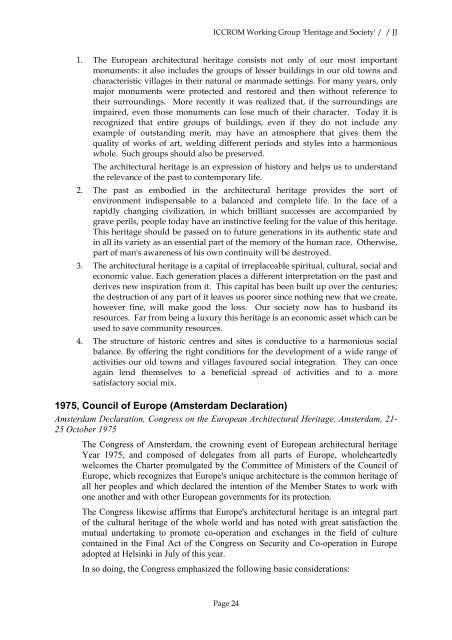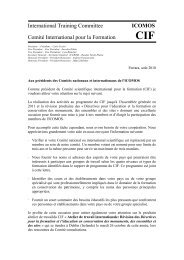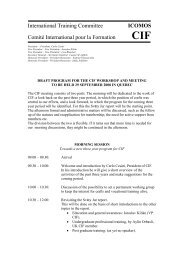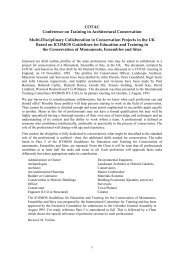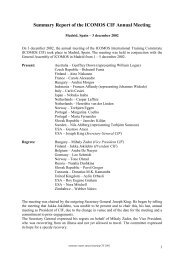Definition of Cultural Heritage -- References to ... - CIF - Icomos
Definition of Cultural Heritage -- References to ... - CIF - Icomos
Definition of Cultural Heritage -- References to ... - CIF - Icomos
You also want an ePaper? Increase the reach of your titles
YUMPU automatically turns print PDFs into web optimized ePapers that Google loves.
ICCROM Working Group '<strong>Heritage</strong> and Society' / / JJ<br />
1. The European architectural heritage consists not only <strong>of</strong> our most important<br />
monuments: it also includes the groups <strong>of</strong> lesser buildings in our old <strong>to</strong>wns and<br />
characteristic villages in their natural or manmade settings. For many years, only<br />
major monuments were protected and res<strong>to</strong>red and then without reference <strong>to</strong><br />
their surroundings. More recently it was realized that, if the surroundings are<br />
impaired, even those monuments can lose much <strong>of</strong> their character. Today it is<br />
recognized that entire groups <strong>of</strong> buildings, even if they do not include any<br />
example <strong>of</strong> outstanding merit, may have an atmosphere that gives them the<br />
quality <strong>of</strong> works <strong>of</strong> art, welding different periods and styles in<strong>to</strong> a harmonious<br />
whole. Such groups should also be preserved.<br />
The architectural heritage is an expression <strong>of</strong> his<strong>to</strong>ry and helps us <strong>to</strong> understand<br />
the relevance <strong>of</strong> the past <strong>to</strong> contemporary life.<br />
2. The past as embodied in the architectural heritage provides the sort <strong>of</strong><br />
environment indispensable <strong>to</strong> a balanced and complete life. In the face <strong>of</strong> a<br />
rapidly changing civilization, in which brilliant successes are accompanied by<br />
grave perils, people <strong>to</strong>day have an instinctive feeling for the value <strong>of</strong> this heritage.<br />
This heritage should be passed on <strong>to</strong> future generations in its authentic state and<br />
in all its variety as an essential part <strong>of</strong> the memory <strong>of</strong> the human race. Otherwise,<br />
part <strong>of</strong> man's awareness <strong>of</strong> his own continuity will be destroyed.<br />
3. The architectural heritage is a capital <strong>of</strong> irreplaceable spiritual, cultural, social and<br />
economic value. Each generation places a different interpretation on the past and<br />
derives new inspiration from it. This capital has been built up over the centuries;<br />
the destruction <strong>of</strong> any part <strong>of</strong> it leaves us poorer since nothing new that we create,<br />
however fine, will make good the loss. Our society now has <strong>to</strong> husband its<br />
resources. Far from being a luxury this heritage is an economic asset which can be<br />
used <strong>to</strong> save community resources.<br />
4. The structure <strong>of</strong> his<strong>to</strong>ric centres and sites is conductive <strong>to</strong> a harmonious social<br />
balance. By <strong>of</strong>fering the right conditions for the development <strong>of</strong> a wide range <strong>of</strong><br />
activities our old <strong>to</strong>wns and villages favoured social integration. They can once<br />
again lend themselves <strong>to</strong> a beneficial spread <strong>of</strong> activities and <strong>to</strong> a more<br />
satisfac<strong>to</strong>ry social mix.<br />
1975, Council <strong>of</strong> Europe (Amsterdam Declaration)<br />
Amsterdam Declaration, Congress on the European Architectural <strong>Heritage</strong>, Amsterdam, 21-<br />
25 Oc<strong>to</strong>ber 1975<br />
The Congress <strong>of</strong> Amsterdam, the crowning event <strong>of</strong> European architectural heritage<br />
Year 1975, and composed <strong>of</strong> delegates from all parts <strong>of</strong> Europe, wholeheartedly<br />
welcomes the Charter promulgated by the Committee <strong>of</strong> Ministers <strong>of</strong> the Council <strong>of</strong><br />
Europe, which recognizes that Europe's unique architecture is the common heritage <strong>of</strong><br />
all her peoples and which declared the intention <strong>of</strong> the Member States <strong>to</strong> work with<br />
one another and with other European governments for its protection.<br />
The Congress likewise affirms that Europe's architectural heritage is an integral part<br />
<strong>of</strong> the cultural heritage <strong>of</strong> the whole world and has noted with great satisfaction the<br />
mutual undertaking <strong>to</strong> promote co-operation and exchanges in the field <strong>of</strong> culture<br />
contained in the Final Act <strong>of</strong> the Congress on Security and Co-operation in Europe<br />
adopted at Helsinki in July <strong>of</strong> this year.<br />
In so doing, the Congress emphasized the following basic considerations:<br />
Page 24


